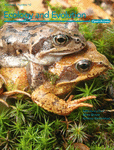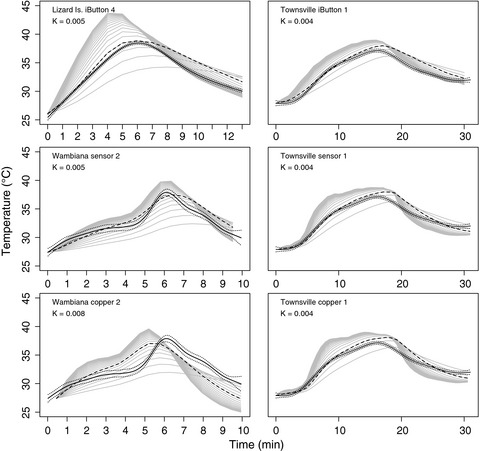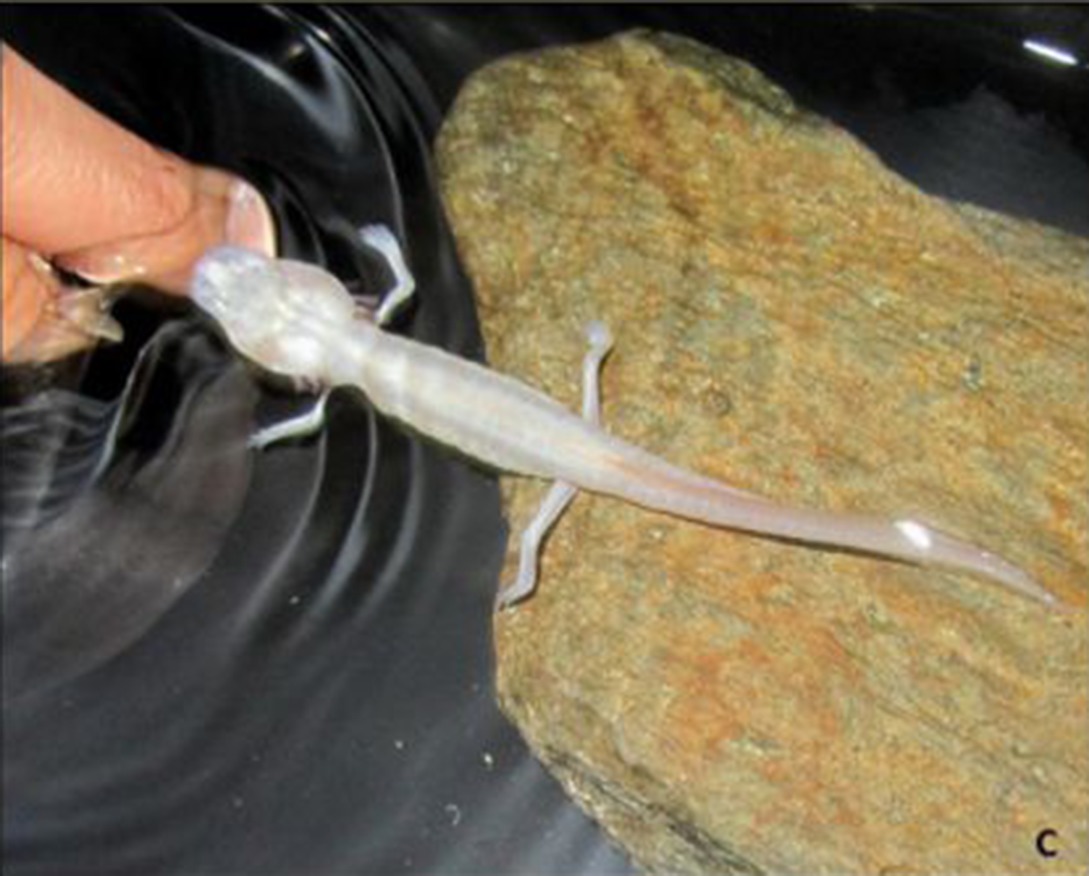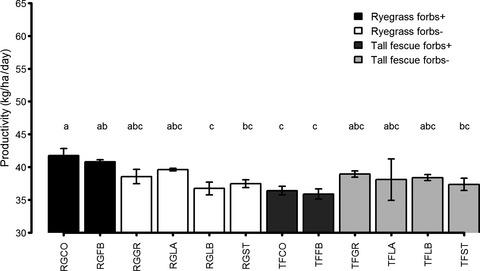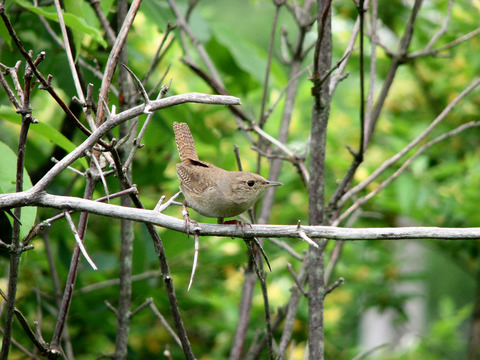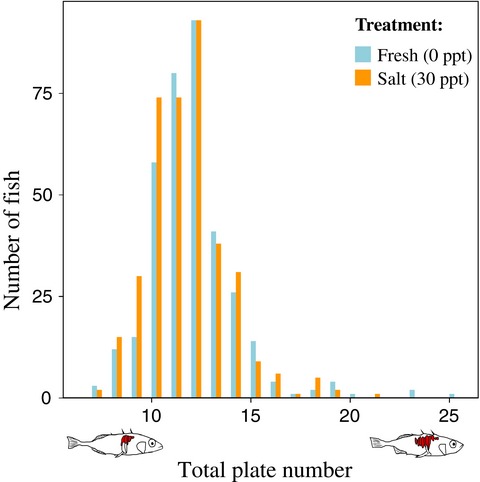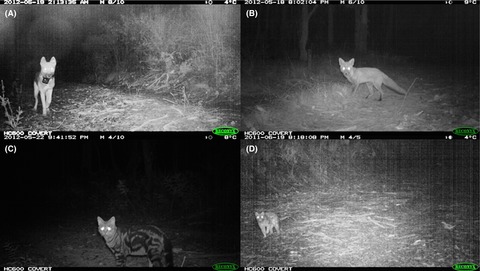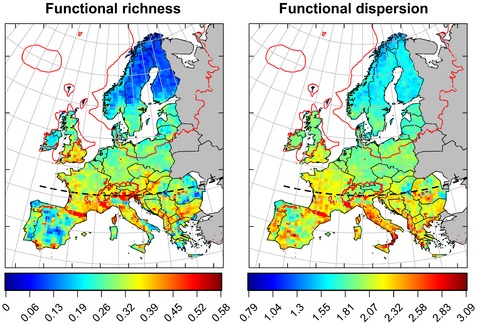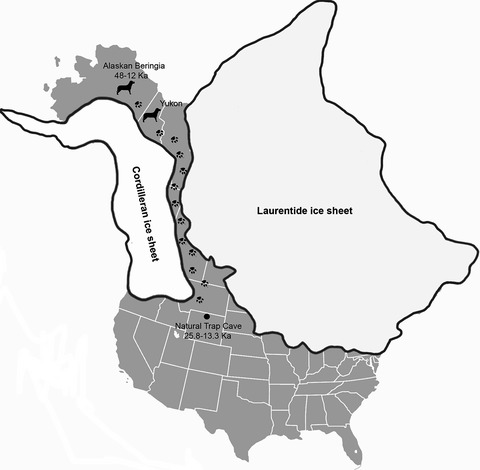Journal list menu
Export Citations
Download PDFs
Issue Information
Original Research
A simple method to predict body temperature of small reptiles from environmental temperature
- Pages: 3059-3066
- First Published: 31 March 2016
Pedigree analysis for the genetic management of group-living species
- Pages: 3067-3078
- First Published: 02 April 2016
Leaf economics spectrum–productivity relationships in intensively grazed pastures depend on dominant species identity
- Pages: 3079-3091
- First Published: 02 April 2016
Phylogenetic assemblage structure of North American trees is more strongly shaped by glacial–interglacial climate variability in gymnosperms than in angiosperms
- Pages: 3092-3106
- First Published: 03 April 2016
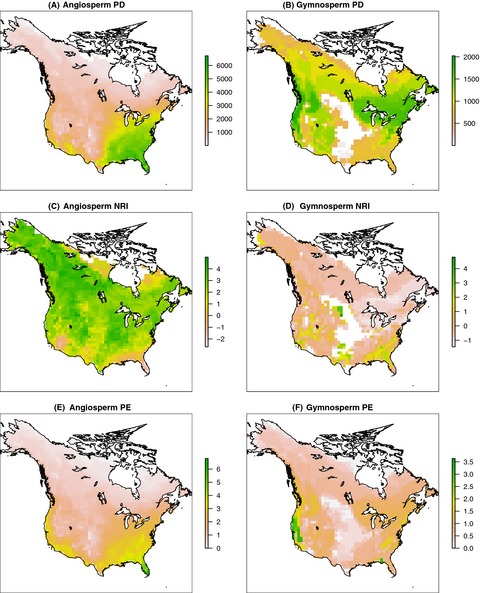
To assess the influence of Quaternary climate change on cross-continental variation in phylogenetic structure, we modeled phylogenetic structures of North American trees in 50-km grid cells as a function of current climate, paleoclimate and topography, comparing angiosperms and gymnosperms. We found current climate had the most influence on the overall patterns, but glacial-interglacial climate change variability determined phylogenetic clustering and endemism, with a greater effect on gymnosperms than angiosperms.
No effect of blood sampling or phytohaemagglutinin injection on postfledging survival in a wild songbird
- Pages: 3107-3114
- First Published: 03 April 2016
Population-specific effects of developmental temperature on body condition and jumping performance of a widespread European frog
- Pages: 3115-3128
- First Published: 03 April 2016
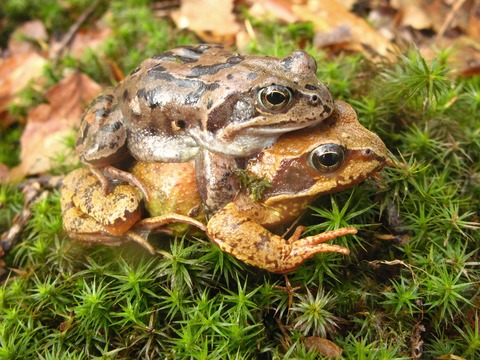
Our results show the intraspecific differences in morphometric traits, physiology, and performance between populations of widespread European frog, inhabiting environments differing in thermal conditions. The differences in traits persistent in the common environments indicate the genetic background as a source of variation. This provides a valuable contribution to the understanding of differences in mechanisms of local thermal adaptations.
Carbon storage in China's forest ecosystems: estimation by different integrative methods
- Pages: 3129-3145
- First Published: 03 April 2016
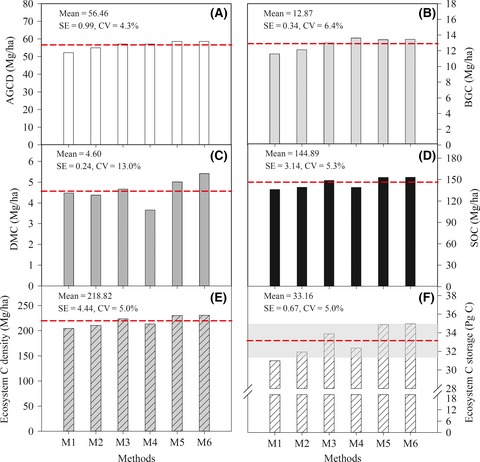
Different integrative methods appear to impact C storage estimates at large scale. C storage in China's forest ecosystems was 30.99–34.96 Pg C by the six integrative methods. Soil C density and storage in the 0–100 cm soil layer were estimated to be 136.07–153.17 Mg C·ha−1 and 20.62–23.21 Pg C, 0.68–0.82. The dead biomass C density and storage were estimated to 3.66–5.41 Mg C·ha−1 and 0.68–0.82 Pg C, respectively. This first evaluation demonstrates the importance of multimethodological approaches to accurately estimate C storage in the large-scale forest ecosystems.
Population dynamics of a natural red deer population over 200 years detected via substantial changes of genetic variation
- Pages: 3146-3153
- First Published: 05 April 2016

We investigate for the first time the change in the genetic constitution of a natural red deer population over two centuries, using up to 200-year-old antlers (30 generations) stored in trophy collections. To the best of our knowledge, this is the oldest DNA source ever used for microsatellite population genetic analyses. We demonstrate that the political situation and hunting laws may have strong impacts on populations that can lead to unexpectedly rapid changes in the genetic constitution of a large mammal population.
Lateral plate number in low-plated threespine stickleback: a study of plasticity and heritability
- Pages: 3154-3160
- First Published: 06 April 2016
Genomic signatures of the plateless phenotype in the threespine stickleback
- Pages: 3161-3173
- First Published: 06 April 2016
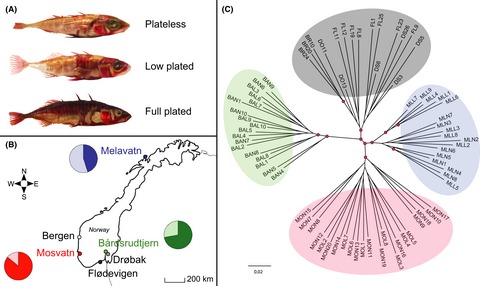
Here we investigate the far extreme of the plate number continuum, the plateless stickleback, an understudied phenotype that has been found in only a few lakes and streams across the world. We use a dense single nucleotide polymorphism (SNP) dataset to analyze samples from three freshwater populations containing plateless individuals. Using a variety of analyses we searched for genomic differences between the low plated and plateless phenotypes both within and among the three lakes finding least 18 genomic regions that may contribute to within-morph plate number in the low plated stickleback populations.
Estimating population size using single-nucleotide polymorphism-based pedigree data
- Pages: 3174-3184
- First Published: 06 April 2016
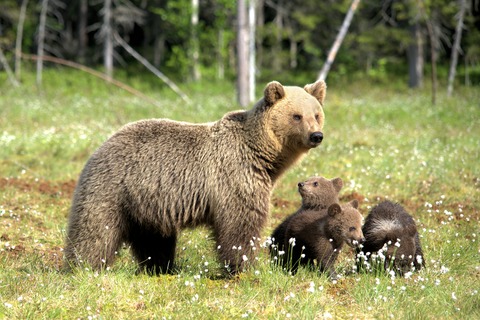
Here, we present empirical analysis of a recently published pedigree-based census method. From two fractions of the Swedish brown bear population, we derived estimates that fall within the 95% CI of the official population estimates. This method, in combination with noninvasive genetic sampling, expands the toolbox of population census methods, particularly for rare and elusive species.
Consequences of mating with siblings and nonsiblings on the reproductive success in a leaf beetle
- Pages: 3185-3197
- First Published: 06 April 2016
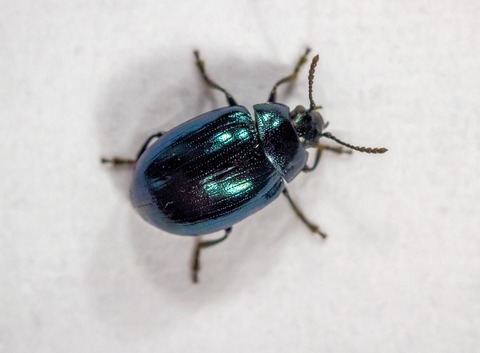
We aimed to investigate the mating behavior and consequences of mating with siblings versus nonsiblings on lifetime reproduction, using five families of a chrysomelid beetle. Additionally, we analyzed the cuticular hydrocarbon profiles, which could serve as potential cues for mate recognition. Although cuticular hydrocarbon profiles differed between families, we could not find a precopulatory inbreeding avoidance behavior, but clear indications for inbreeding depression.
Peripheral genetic structure of Helicoverpa zea indicates asymmetrical panmixia
- Pages: 3198-3207
- First Published: 06 April 2016
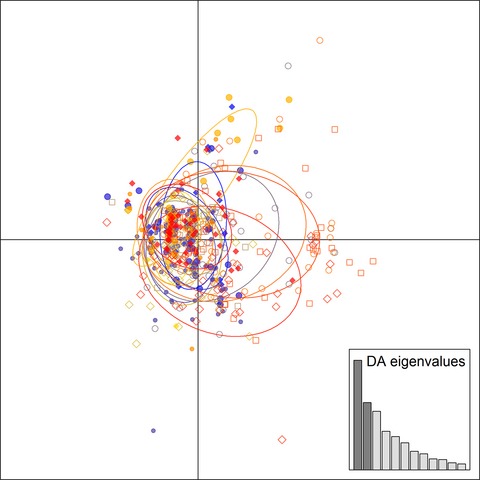
Adult Helicoverpa zea moths captured in pheromone traps in two locations in Pennsylvania were genotyped for microsatellite loci. Statistical genetic analysis of microsatellite data indicated that high genetic diversity within migrant populations and low genetic differentiation among migrant populations of H. zea are the result of asymmetrical immigration due to the high dispersal and reproductive behavior of H. zea.
Validation of back-calculated body lengths and timing of growth mark deposition in Hawaiian green sea turtles
- Pages: 3208-3215
- First Published: 06 April 2016
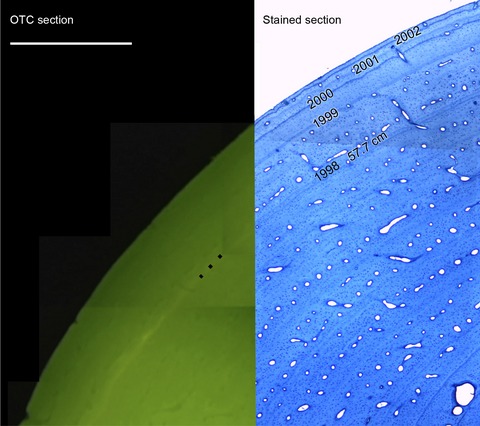
Carapace lengths of wild, mark-recaptured green sea turtles in Hawaii, USA were compared with carapace lengths estimated from growth mark diameters retained in their humerus bones. We found no significant difference, which supports using skeletochronology to convert successive growth mark diameters to prior carapace lengths and rapidly access a record of prior growth rates for this species.
Are we getting the full picture? Animal responses to camera traps and implications for predator studies
- Pages: 3216-3225
- First Published: 06 April 2016
Adcyap1 polymorphism covaries with breeding latitude in a Nearctic migratory songbird, the Wilson's warbler (Cardellina pusilla)
- Pages: 3226-3239
- First Published: 07 April 2016
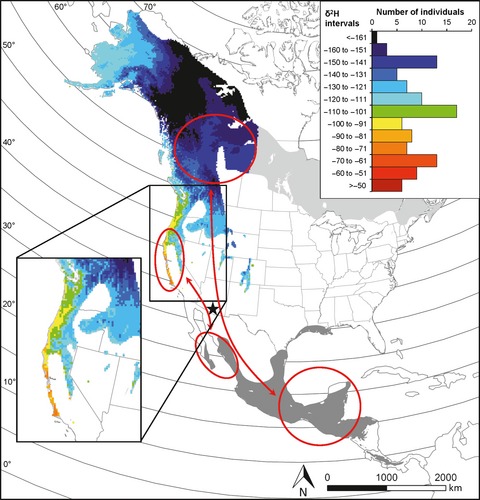
We investigated whether genetic polymorphism at two migration-linked candidate genes, Clock and Adcyap1, predicted phenotypic variation in timing of spring migration and breeding latitude in western populations of a Nearctic migratory songbird, the Wilson's warbler (Cardellina pusilla). While Clock was monomorphic, Adcyap1 allele size strongly (r = 0.69) predicted latitude of the breeding destination, inferred from stable isotope ratios of feathers, of long-distance, northern breeding populations (western Canada), while this was not the case (r = 0.12) among southern breeding birds (coastal California). We also found that Adcyap1 significantly covaried with inferred breeding latitude of males but not of females. No association was found between Adcyap1 allele size and spring migration timing. These findings are consistent with the hypothesis that Adcyap1 is involved in the regulation of migratory behavior.
Shift in precipitation regime promotes interspecific hybridization of introduced Coffea species
- Pages: 3240-3255
- First Published: 08 April 2016
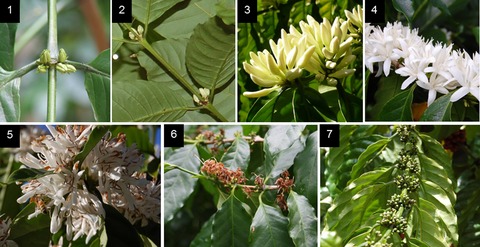
Differentiation in flowering time and in native environmental conditions contributes to reproductive isolation between Coffea species. We investigated the impact of Coffea species introduction to New Caledonia in new environmental conditions on their flowering phenologies and on the hybridization potential in this secondary contact zone. Using a combination of population genetics and niche modeling, together with flowering and climate monitoring, we showed that the presence of a precipitation regime different from those in Africa generated partial flowering overlap between species and promoted hybridization and gene flow.
Aversion and attraction to harmful plant secondary compounds jointly shape the foraging ecology of a specialist herbivore
- Pages: 3256-3268
- First Published: 08 April 2016
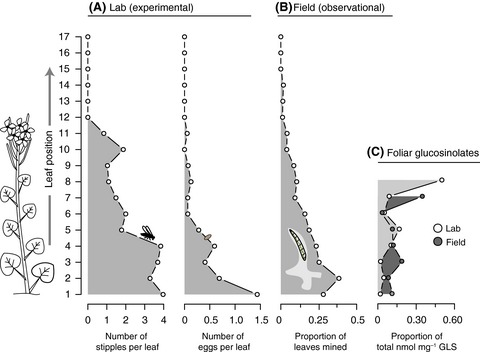
Many specialists herbivores can subvert host plant defensive chemistry, allowing them to “feed with impunity” on plant tissues. But despite being a specialist herbivore, Scaptomyza nigrita lacks a specialized means of overcoming the toxic mustard oils of its Brassicacea host. Here, we show that this herbivore exhibits a behavioral strategy for mitigating host plant toxicity by avoiding high concentrations of mustard oil precursors where possible, even though these compounds themselves may be important for initiating host feeding.
Structural (UV) and carotenoid-based plumage coloration – signals for parental investment?
- Pages: 3269-3279
- First Published: 09 April 2016
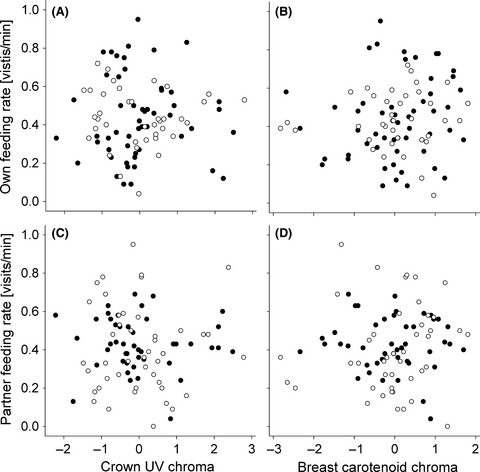
We investigated whether pre- and/or posthatching investment of blue tit (Cyanistes caeruleus) parents was related to ornamental plumage traits (UV crown coloration and carotenoid-based plumage coloration) expressed by either the individual itself or its partner. Most traits were not linked to plumage coloration, except for a consistent positive relationship between offspring begging intensity and maternal carotenoid-based plumage coloration. This is likely to represent a maternal effect mediated via maternally derived egg substances.
Nuclear introgression without mitochondrial introgression in two turtle species exhibiting sex-specific trophic differentiation
- Pages: 3280-3288
- First Published: 12 April 2016

Our study couples stable isotope analysis with genetic sequence data to examine sex-specific introgression and trophic differentiation in two hybridizing turtle species. We found that introgression occurs through males but is halted in females. Trophic differences in females may provide a mechanism that can contribute to reduced hybrid female fitness.
Geographic variation in advertisement calls of a Microhylid frog – testing the role of drift and ecology
- Pages: 3289-3298
- First Published: 12 April 2016

Call divergence, geographic distance and genetic distance between M. fissipes populations were positively correlated. These results, combined with the Pst − Fst test, suggested a role of drift. We concluded that genetic drift, rather than ecological processes, is the more likely driver for the geographic variation in the advertisement calls of M. fissipes.
A trait-based approach reveals the feeding selectivity of a small endangered Mediterranean fish
- Pages: 3299-3310
- First Published: 12 April 2016

Although functional traits are growing in popularity in modern ecology, feeding studies remain firmly rooted in a taxonomic-based perspective. Our study shows that morphological and behavioral traits may explain prey vulnerability to predation and, consequently, suggests that the adoption of a trait-based perspective in feeding ecology studies can improve our mechanistic understanding of prey–consumer relationships.
Contrasting genetic patterns between two coexisting Eleutherococcus species in northern China
- Pages: 3311-3324
- First Published: 12 April 2016
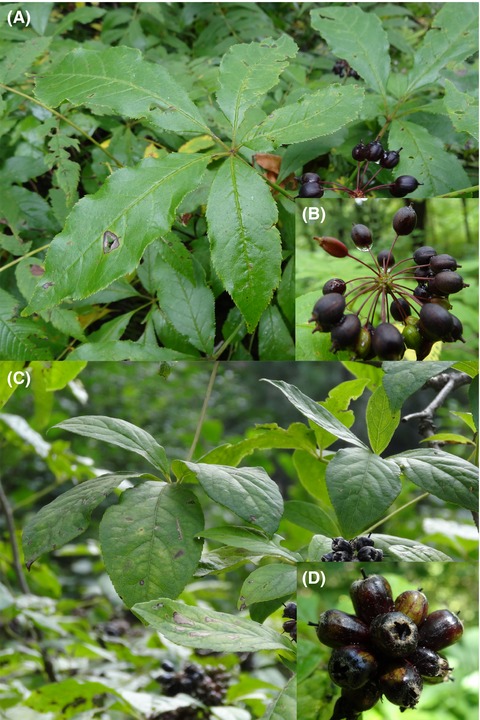
We evaluated whether two coexisting Eleutherococcus species had similar demographic history based on chloroplast fragment sequencing. Our study found extremely contrasting genetic patterns between the two coexisting close relatives, with E. sessiliflorus found only one haplotype, whereas E. senticosus found considerably high genetic variation in both North China and Northeast China (total 15 haplotypes). We speculated that a recent severe bottleneck might have resulted in the extremely low genetic diversity in E. sessiliflorus; for E. senticosus, we inferred that both North China and Northeast China could sustain populations during last glacial maximum, and lineage admixture between multiple glacial refugia might elevate the genetic diversity in Northeast China.
Photosynthesis, growth, and decay traits in Sphagnum – a multispecies comparison
- Pages: 3325-3341
- First Published: 12 April 2016
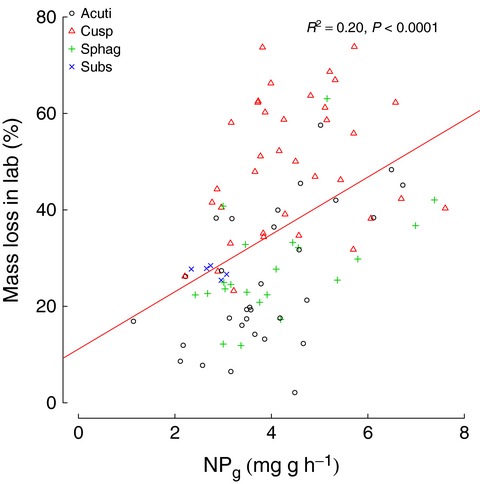
We investigated functional traits related to growth and decomposition (and hence decisive for carbon sequestration) in 15 globally important Sphagnum species representing a range of peatland habitats. By including a wide range of species and habitats, we found that the trade-off between measures of growth and decomposition was weaker than indicated by previous studies. We also show that the assumed strong link between phylogeny and trait is an oversimplification, and we discuss trait differences among species representing different habitats and phylogeny.
Long-term demographic decline and late glacial divergence in a Californian paleoendemic: Sequoiadendron giganteum (giant sequoia)
- Pages: 3342-3355
- First Published: 12 April 2016
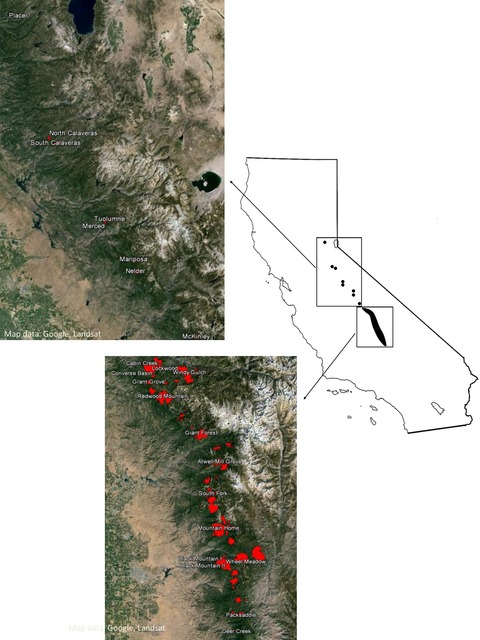
We used nuclear microsatellites to investigate the evolution of contemporary population genetic structure among groves of the Californian paleoendemic giant sequoia (Sequoiadendron giganteum). Populations north of the Kings Canyon watershed were found to be genetically divergent from the more continuous groves further south. Our data supported a demographic contraction just prior to the last glacial maximum as the most likely scenario for the current disjunct range of the species, superimposed upon a long term decline of giant sequoia over the last 2 million years, associated with increasing aridity due to the Mediterranean climate.
Prefire grazing by cattle increases postfire resistance to exotic annual grass (Bromus tectorum) invasion and dominance for decades
- Pages: 3356-3366
- First Published: 12 April 2016
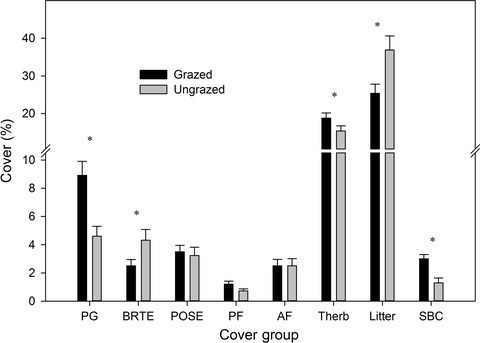
We evaluated the influence of grazing of native plant community resilience to fire and resistance to exotic annual grass invasion for more than 20 years postfire. Grazing prefire compared to long-term grazing exclusion increased native plant community recovery and decreased exotic annual grass dominance postfire.
Divergence and isolation of cryptic sympatric taxa within the annual legume Amphicarpaea bracteata
- Pages: 3367-3379
- First Published: 12 April 2016
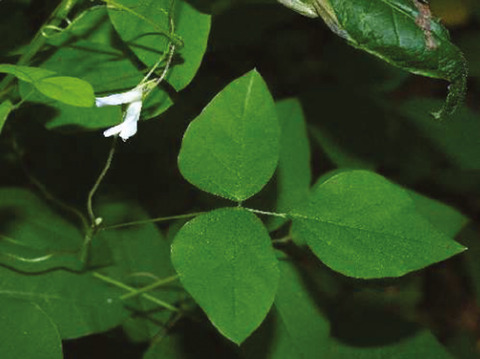
The highly selfing annual legume Amphicarpaea bracteata consists of three strongly divergent, extremely homozygous cryptic lineages. Genotyping-by-sequencing shows that these lineages maintain islands of genetic divergence that likely underlie hybrid incompatibility, restricting gene flow despite widespread sympatric distributions. Furthermore, although genetic diversity is very low, each lineages nevertheless displays substantial phenotypic variation, complicating identification in the field.
Assessing the geographic scale of genetic population management with microsatellites and introns in the clam Ruditapes decussatus
- Pages: 3380-3404
- First Published: 15 April 2016
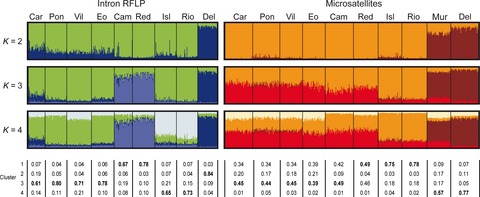
The clam Ruditapes decussatus is a commercial species from the northwestern Atlantic and the Mediterranean that is facing population decline and hybridization with the introduced Manila clam. To help in genetic population management, we have conducted a population survey with microsatellites and intron RFLP markers. A regional pattern of population subdivision in the Atlantic has been found.
Strong paleoclimatic legacies in current plant functional diversity patterns across Europe
- Pages: 3405-3416
- First Published: 18 April 2016
Winners and losers: tropical forest tree seedling survival across a West African forest–savanna transition
- Pages: 3417-3429
- First Published: 18 April 2016
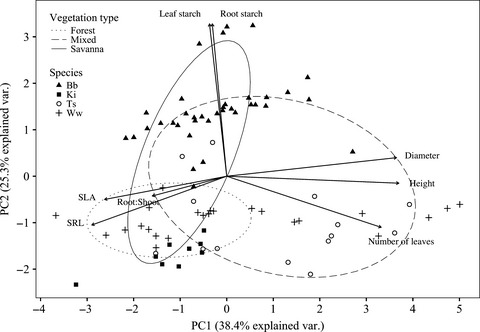
Survival after fire of different forest tree seedling species was associated to trade-offs between growth and resource capture ability and ability to recover from fire. Therefore, other factors than fire confer different acclimation strategies that determine the survival of forest tree seedlings in each vegetation type.
Extinct Beringian wolf morphotype found in the continental U.S. has implications for wolf migration and evolution
- Pages: 3430-3438
- First Published: 24 April 2016
Corrigendum
Loss of genetic integrity and biological invasions result from stocking and introductions of Barbus barbus: insights from rivers in England
- Page: 3439
- First Published: 17 May 2016




